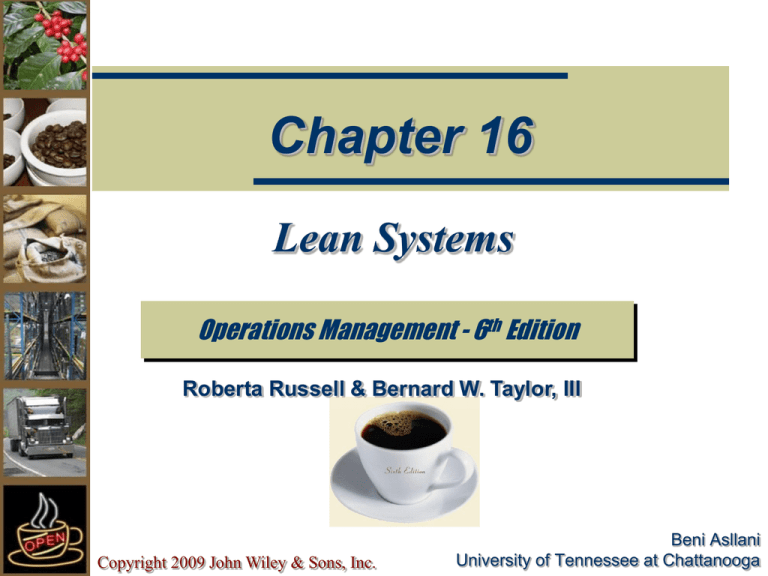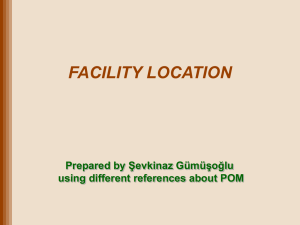
Chapter 16
Lean Systems
Operations Management - 6th Edition
Roberta Russell & Bernard W. Taylor, III
Copyright 2009 John Wiley & Sons, Inc.
Beni Asllani
University of Tennessee at Chattanooga
Lecture Outline
Basic Elements of Lean Production
Benefits of Lean Production
Implementing Lean Production
Lean Services
Leaning the Supply Chain
Lean Six Sigma
Lean and the Environment
Lean Consumption
Copyright 2009 John Wiley & Sons, Inc.
16-2
Lean Production
Doing more with less inventory, fewer
workers, less space
Just-in-time (JIT)
smoothing the flow of material to arrive
just as it is needed
“JIT” and “Lean Production” are used
interchangeably
Muda
waste, anything other than that which
adds value to product or service
Copyright 2009 John Wiley & Sons, Inc.
16-3
Waste in Operations
Copyright 2009 John Wiley & Sons, Inc.
16-4
Waste in Operations (cont.)
Copyright 2009 John Wiley & Sons, Inc.
16-5
Waste in Operations (cont.)
Copyright 2009 John Wiley & Sons, Inc.
16-6
Basic Elements
1.
2.
3.
4.
5.
6.
7.
8.
9.
10.
Flexible resources
Cellular layouts
Pull system
Kanbans
Small lots
Quick setups
Uniform production levels
Quality at the source
Total productive
maintenance
Supplier networks
Copyright 2009 John Wiley & Sons, Inc.
16-7
Flexible Resources
Multifunctional workers
perform more than one job
general-purpose machines perform
several basic functions
Cycle time
time required for the worker to complete
one pass through the operations
assigned
Takt time
paces production to customer demand
Copyright 2009 John Wiley & Sons, Inc.
16-8
Standard Operating
Routine for a Worker
Copyright 2009 John Wiley & Sons, Inc.
16-9
Cellular Layouts
Manufacturing cells
comprised of dissimilar machines brought
together to manufacture a family of parts
Cycle time is adjusted to match takt time
by changing worker paths
Copyright 2009 John Wiley & Sons, Inc.
16-10
Cells with Worker Routes
Copyright 2009 John Wiley & Sons, Inc.
16-11
Worker Routes Lengthen as
Volume Decreases
Copyright 2009 John Wiley & Sons, Inc.
16-12
Pull System
Material is pulled through the system when
needed
Reversal of traditional push system where
material is pushed according to a schedule
Forces cooperation
Prevent over and underproduction
While push systems rely on a predetermined
schedule, pull systems rely on customer
requests
Copyright 2009 John Wiley & Sons, Inc.
16-13
Kanbans
Card which indicates standard quantity
of production
Derived from two-bin inventory system
Maintain discipline of pull production
Authorize production and movement of
goods
Copyright 2009 John Wiley & Sons, Inc.
16-14
Sample Kanban
Copyright 2009 John Wiley & Sons, Inc.
16-15
Origin of Kanban
a) Two-bin inventory system
b) Kanban inventory system
Bin 1
Kanban
Bin 2
Reorder
card
Q-R
R
R
Q = order quantity
R = reorder point - demand during lead time
Copyright 2009 John Wiley & Sons, Inc.
16-16
Types of Kanban
Production kanban
authorizes production of
goods
Signal kanban
Withdrawal kanban
authorizes movement of
goods
Kanban square
a marked area designated
to hold items
Material kanban
used to order material in
advance of a process
Supplier kanban
Copyright 2009 John Wiley & Sons, Inc.
a triangular kanban
used to signal
production at the
previous workstation
rotates between the
factory and suppliers
16-17
Copyright 2009 John Wiley & Sons, Inc.
16-18
Copyright 2009 John Wiley & Sons, Inc.
16-19
Copyright 2009 John Wiley & Sons, Inc.
16-20
Determining Number of
Kanbans
No. of Kanbans =
average demand during lead time + safety stock
container size
dL + S
N =
C
where
N
d
L
S
C
= number of kanbans or containers
= average demand over some time period
= lead time to replenish an order
= safety stock
= container size
Copyright 2009 John Wiley & Sons, Inc.
16-21
Determining Number of
Kanbans: Example
d
L
S
C
= 150 bottles per hour
= 30 minutes = 0.5 hours
= 0.10(150 x 0.5) = 7.5
= 25 bottles
(150 x 0.5) + 7.5
dL + S
N=
=
25
C
75 + 7.5
=
= 3.3 kanbans or containers
25
Round up to 4 (to allow some slack) or
down to 3 (to force improvement)
Copyright 2009 John Wiley & Sons, Inc.
16-22
Small Lots
Require less space and capital
investment
Move processes closer together
Make quality problems easier to
detect
Make processes more dependent
on each other
Copyright 2009 John Wiley & Sons, Inc.
16-23
Inventory Hides Problems
Copyright 2009 John Wiley & Sons, Inc.
16-24
Less Inventory Exposes Problems
Copyright 2009 John Wiley & Sons, Inc.
16-25
Components of Lead Time
Processing time
Reduce number of items or improve efficiency
Move time
Reduce distances, simplify movements, standardize
routings
Waiting time
Better scheduling, sufficient capacity
Setup time
Generally the biggest bottleneck
Copyright 2009 John Wiley & Sons, Inc.
16-26
Quick Setups
Internal setup
Can be performed
only when a
process is stopped
External setup
Can be performed
in advance
Copyright 2009 John Wiley & Sons, Inc.
SMED Principles
Separate internal setup from
external setup
Convert internal setup to external
setup
Streamline all aspects of setup
Perform setup activities in
parallel or eliminate them entirely
16-27
Common Techniques for Reducing
Setup Time
Copyright 2009 John Wiley & Sons, Inc.
16-28
Common Techniques for Reducing
Setup Time (cont.)
Copyright 2009 John Wiley & Sons, Inc.
16-29
Common Techniques for Reducing
Setup Time (cont.)
Copyright 2009 John Wiley & Sons, Inc.
16-30
Uniform Production Levels
Result from smoothing production
requirements on final assembly line
Kanban systems can handle +/- 10%
demand changes
Reduce variability with more accurate
forecasts
Smooth demand across planning
horizon
Mixed-model assembly steadies
component production
Copyright 2009 John Wiley & Sons, Inc.
16-31
Mixed-Model Sequencing
Copyright 2009 John Wiley & Sons, Inc.
16-32
Quality at the Source
Visual control
makes problems visible
Poka-yokes
prevent defects from
occurring
Kaizen
a system of continuous
improvement; “change for
the good of all”
Copyright 2009 John Wiley & Sons, Inc.
Jidoka
authority to stop the
production line
Andons
call lights that signal
locations of quality
problems
Under-capacity
scheduling
leaves time for planning,
problem solving, and
maintenance
16-33
Examples of Visual
Control
Copyright 2009 John Wiley & Sons, Inc.
16-34
Examples of Visual
Control (cont.)
Copyright 2009 John Wiley & Sons, Inc.
16-35
Examples of Visual
Control (cont.)
Copyright 2009 John Wiley & Sons, Inc.
16-36
5 Whys
One of the keys to an effective Kaizen is
finding the root cause of a problem and
eliminating it
A practice of asking “why?” repeatedly
until the underlying cause is identified
(usually requiring five questions)
Simple, yet powerful technique for finding
the root cause of a problem
Copyright 2009 John Wiley & Sons, Inc.
16-37
Total Productive
Maintenance (TPM)
Breakdown maintenance
Repairs to make failed machine operational
Preventive maintenance
System of periodic inspection and
maintenance to keep machines operating
TPM combines preventive maintenance
and total quality concepts
Copyright 2009 John Wiley & Sons, Inc.
16-38
TPM Requirements
Design products that can be easily produced
on existing machines
Design machines for easier operation,
changeover, maintenance
Train and retrain workers to operate machines
Purchase machines that maximize productive
potential
Design preventive maintenance plan spanning
life of machine
Copyright 2009 John Wiley & Sons, Inc.
16-39
5S Scan
Seiri(sort)
Seiton(set in order)
Seisou (shine)
Seiketsu
(standardize)
Goal
Keep only what you
need
A place for
everything and
everything in its
place
Cleaning, and
looking for ways to
keep clean and
organized
Maintaining and
monitoring the first
three categories
Sticking to the rules
Shisuke (sustain)
Copyright 2009 John Wiley & Sons, Inc.
Eliminate or Correct
Unneeded equipment, tools, furniture;
unneeded items on walls, bulletins; items
blocking aisles or stacked in corners;
unneeded inventory, supplies, parts; safety
hazards
Items not in their correct places; correct
places not obvious; aisles, workstations, &
equipment locations not indicated; items not
put away immediately after use
Floors, walls, stairs, equipment, & surfaces
not clean; cleaning materials not easily
accessible; lines, labels, signs broken or
unclean; other cleaning problems
Necessary information not visible; standards
not known; checklists missing; quantities and
limits not easily recognizable; items can’t be
located within 30 seconds
Number of workers without 5S training;
number of daily 5S inspections not performed;
number of personal items not stored; number
of times job aids not available or up-to-date
16-40
Supplier Networks
Long-term supplier contracts
Synchronized production
Supplier certification
Mixed loads and frequent deliveries
Precise delivery schedules
Standardized, sequenced delivery
Locating in close proximity to the customer
Copyright 2009 John Wiley & Sons, Inc.
16-41
Benefits of Lean
Production
Reduced inventory
Improved quality
Lower costs
Reduced space requirements
Shorter lead time
Increased productivity
Copyright 2009 John Wiley & Sons, Inc.
16-42
Benefits of Lean
Production (cont.)
Greater flexibility
Better relations with suppliers
Simplified scheduling and control activities
Increased capacity
Better use of human resources
More product variety
Copyright 2009 John Wiley & Sons, Inc.
16-43
Implementing Lean Production
Use lean production to finely tune an
operating system
Somewhat different in USA than Japan
Lean production is still evolving
Lean production is not for everyone
Copyright 2009 John Wiley & Sons, Inc.
16-44
Lean Services
Basic elements of lean
production apply equally to
services
Most prevalent applications
lean retailing
lean banking
lean health care
Dr. John Long
Copyright 2009 John Wiley & Sons, Inc.
16-45
Leaning the Supply Chain
“pulling” a smooth flow of material through a
series of suppliers to support frequent
replenishment orders and changes in customer
demand
Firms need to share information and
coordinate demand forecasts, production
planning, and inventory replenishment with
suppliers and supplier’s suppliers throughout
supply chain
Copyright 2009 John Wiley & Sons, Inc.
16-46
Leaning the Supply Chain (cont.)
Steps in Leaning the Supply Chain:
Build a highly collaborative business
environment
Adopt the technology to support your
system
Copyright 2009 John Wiley & Sons, Inc.
16-47
Lean Six Sigma
Lean and Six Sigma are natural partners for
process improvement
Lean
Eliminates waste and creates flow
More continuous improvement
Six Sigma
Reduces variability and enhances process
capabilities
Requires breakthrough improvements
Copyright 2009 John Wiley & Sons, Inc.
16-48
Lean and the Environment
Lean’s mandate to eliminate waste and
operate only with those resources that
are absolutely necessary aligns well with
environmental initiatives
Environmental waste is often an indicator
of poor process design and inefficient
production
Copyright 2009 John Wiley & Sons, Inc.
16-49
EPA Recommendations
Commit to eliminate environmental waste through lean
implementation
Recognize new improvement opportunities by
incorporating environmental, heath and safety (EHS)
icons and data into value stream maps
Involve staff with EHS expertise in planning
Find and drive out environmental wastes in specific
process by using lean process-improvement tools
Empower and enable workers to eliminate
environmental wastes in their work areas
Copyright 2009 John Wiley & Sons, Inc.
16-50
Lean Consumption
Consumptions process involves locating,
buying, installing, using, maintaining, repairing,
and recycling.
Lean Consumption seeks to:
Provide customers what they want, where and
when they want it
Resolve customer problems quickly and completely
Reduce the number of problems customers need to
solve
Copyright 2009 John Wiley & Sons, Inc.
16-51
Copyright 2009 John Wiley & Sons, Inc.
All rights reserved. Reproduction or translation of this work beyond that
permitted in section 117 of the 1976 United States Copyright Act without
express permission of the copyright owner is unlawful. Request for further
information should be addressed to the Permission Department, John Wiley &
Sons, Inc. The purchaser may make back-up copies for his/her own use only and
not for distribution or resale. The Publisher assumes no responsibility for
errors, omissions, or damages caused by the use of these programs or from the
use of the information herein.
Copyright 2009 John Wiley & Sons, Inc.
16-52









